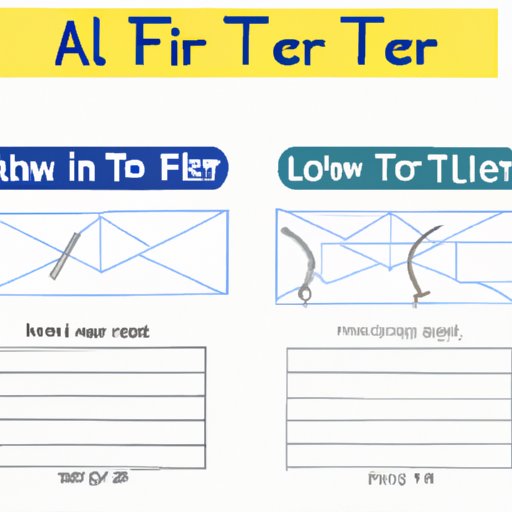
I. Introduction
Writing a letter is an important skill that everyone should have, whether for personal or professional purposes. However, many people struggle with the process of filling out a letter correctly. One mistake can lead to a poorly written letter, which can have consequences ranging from miscommunications to missed opportunities. In this article, we will provide a tutorial on how to fill out a letter, including step-by-step guidance, common mistakes to avoid, types of letters, templates and samples, writing tips, and letter filling tools.
II. Step-by-Step Tutorial
Before starting to write a letter, it’s important to organize your thoughts and determine what information you need to convey. Here are the steps to follow when filling out a letter:
Step 1: Choose your format
Choose the appropriate format for your letter, such as block, modified block, or semi-block format. This will determine where you place the date, salutation, body, closing, and signature sections of the letter.
Step 2: Add the date and address
Include the date and address at the top of the letter. The date should be written out in full, with the month, day, and year (e.g. January 1, 2022). The address should include the recipient’s name, title, organization, and mailing address.
Step 3: Write the salutation
Write the salutation to address the recipient. If you know the person’s name, use their full name with a title (e.g. Dear Dr. Smith). If you don’t know their name, use a general salutation (e.g. To Whom It May Concern).
Step 4: Compose the body of the letter
Begin by introducing yourself and explaining the purpose of the letter. Use short, clear paragraphs to convey your thoughts and be direct in your message. Provide relevant details and examples to support your points.
Step 5: Add the closing and signature
In the closing section, reiterate your purpose and thank the recipient for their time and consideration. End with a formal closing (e.g. Sincerely) and add your signature underneath.
III. Common Mistakes to Avoid
Even if you follow the steps outlined in the tutorial, there are common mistakes that people make when writing letters. Here are some mistakes to avoid:
Mistake 1: Not being specific enough
Be sure to clearly state your purpose in the letter and provide specific details about what you are requesting or offering. Avoid vague or broad statements that could lead to confusion.
Mistake 2: Using informal language
Letters should be written in a formal tone, regardless of the subject matter. Avoid using slang, contractions, or overly casual language.
Mistake 3: Neglecting to proofread
Always proofread your letter for grammar, spelling, and punctuation errors. A letter with mistakes can make you appear unprofessional and careless.
IV. Types of Letters
There are various types of letters that people may need to fill out. Here are some examples:
Job application letters
A job application letter should showcase your skills, experience, and qualifications for a specific job. It should be tailored to the job posting and highlight why you are the best candidate.
Cover letters
A cover letter is often used alongside a job application and provides a brief overview of your qualifications and why you are interested in the position. It should be personalized and demonstrate your enthusiasm for the role.
Business letters
Business letters are used for various purposes, such as introducing yourself or your company, making inquiries, or requesting information. They should be professional and convey a clear message.
Thank-you letters
A thank-you letter is a courteous way to show appreciation to someone for their time, assistance, or support. It should be sincere and personalized.
V. Template and Sample
You can use a template or sample letter as a starting point for your own letter. Here are some tips for customizing a template or sample:
Tip 1: Personalize the letter
Make the letter your own by adding personal details and adjusting the content to fit your specific situation.
Tip 2: Cut unnecessary information
Review the template or sample and remove any information that is not relevant or necessary for your letter.
Tip 3: Proofread and edit
Ensure that the letter is free of errors and that it flows well. Edit as needed to make the letter more clear and concise.
VI. Writing Tips and Tricks
Here are some general writing tips that can be applied to any type of letter:
Tip 1: Use active voice
Using active voice can make your letter more concise and engaging. Active voice puts the focus on the subject of the sentence, making the message more direct.
Tip 2: Be concise
Avoid using filler words or unnecessary information. Keep the message concise and to the point.
Tip 3: Use a friendly tone
While letters should be formal, it’s important to use a friendly and approachable tone. This can make the letter more engaging and help to build rapport with the recipient.
VII. Letter Filling Tools
There are various tools and resources that can make filling out letters easier. Here are some examples:
Grammar checking tools
Tools like Grammarly can help to ensure that your letter is free of grammar, spelling, and punctuation errors.
Sample letter databases
Websites like LiveCareer and Monster offer databases of sample letters for various purposes, which can help guide you in crafting your own letter.
Letter writing services
If you need professional assistance with writing or editing a letter, you can consider hiring a letter writing service. These services can help you create polished and effective letters.
VIII. Conclusion
To write an effective letter, it’s important to have a clear plan and to avoid common mistakes. By following the step-by-step tutorial, avoiding common mistakes, understanding the types of letters, using templates and samples, applying writing tips, and utilizing letter filling tools, anyone can create effective letters that communicate with clarity and confidence.
If you need further assistance with letter writing, there are many resources available. Use the tools and tips provided in this article as a starting point, and don’t hesitate to seek additional help if needed.




